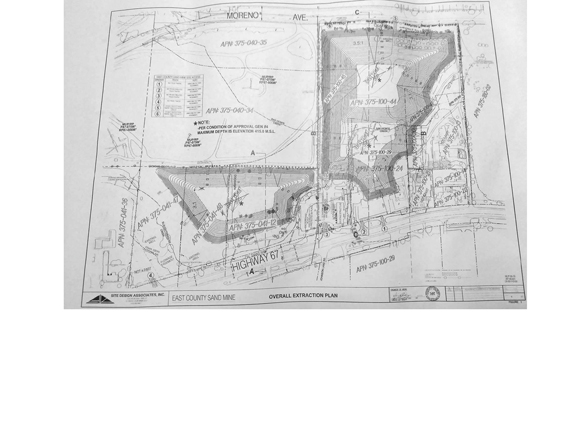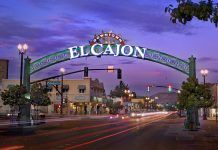“I live in an agricultural area and appreciate the peace and quiet for which I am entitled,” stated the letter Moreno Valley resident Billi-Jo Swanson sent in 2015 to Mark Wardlaw, the Director of the Planning & Development Services with the county of San Diego. Swanson lived in this Lakeside valley since the early 1960’s and is protesting against a new on-going sand mining project on its way to be approved right across from her home.
“I live in an agricultural area and appreciate the peace and quiet for which I am entitled,” stated the letter Moreno Valley resident Billi-Jo Swanson sent in 2015 to Mark Wardlaw, the Director of the Planning & Development Services with the county of San Diego. Swanson lived in this Lakeside valley since the early 1960’s and is protesting against a new on-going sand mining project on its way to be approved right across from her home. Moreno Valley has a few decades long history of being a farming area unwillingly succumbed under a fast and initially deregulated industrial pursuit that is now regarded by many locals as a “status quo” that no one could do anything about it (or wanting to). However, Mrs. Swanson is “against all the sand mining and rock crushing” that causes “terrible noise” which is “ear splitting” and lots of dust for which she could bear witness with many pictures she emailed to Wardlaw, with apparently no success. There are several other sand mining companies making a buck in the area and one simple trip around town on Channel Rd or Highway 67 would paint the picture of the half farming, half sand mining country town that’s Lakeside.
The new sand mining project is located on 27.39 acres of land belonging to local benefactor and respected businessman, Bob Turner. The sand mining area occupies 19.23 acres and the final restored area will be a little over 23 acres zoned for sand mining. The project was on the agenda for approval last week in the Lakeside Planning Committee. Although this committee has only an advisory role and the project will have to be officially approved by the county (on the agenda on June 9), President Milton Cyphert conjured the local community to attend the meeting with Turner and his engineer and comment on the project. Only 14 people showed up, including Turner’s family and business associates. The very few locals in the room expressed their concerns related mostly to the traffic, which is already a huge issue with Moreno Rd being used as an alternative route to Highway 67 and with Vigilante Road being backed up as well during rush hours – issue raised by Debra Montgomery and several others who proposed that Turner uses the same exit as another sand miner in the valley, Ennis, Inc. (not possible).
Kenneth J. Discenza, the project engineer, claims that the traffic could be worse, but because the county requested phasing this project out to allow only 10 trucks per hour, it would take 15 years instead of “about a couple of years, mostly five, if we could just go out there and do all the work at once.” Asked about how would this project impact the aquifer, Cyphert pointed out that the amount of sand to be extracted was slashed in half by the county just so the water table (situated at 25 ft.) won’t be affected by the digging (still at 25 ft. deep). The approach was to disregard the concerns about polluting the aquifer in the process, counting on luck to prevent any unwanted accidents that may compromise the underground water.
Swanson spoke about the noise and air pollutions and Steve Robak, member on the committee, explained, “We were well aware of the sand mining and constructions sites when we bought our house there. This is just the way it is, Moreno is an industrialized valley, ” forgetting that Swanson moved here in the 60’s and this is a new sand mining project just across from her house. Robak pointed out “Bob (Turner) is a good guy” and that “I initially thought I could not live by the train tracks, but after a couple of months, I didn’t hear the trains anymore.” Robak was seconded by another committee member, Brian Sesko, who addressed Swanson by saying that “maybe it’s unfortunate for you and you’re going to be affected more than everybody else, but this is no different than me trying to bend off the fact that the State was telling me that my cows can’t fart, but that’s the reality we are dealing with.”
Not everybody seemed to be favorable to this half stoic, half sarcastic approach to how businesses impact people’s quality of life, as several other locals took to the microphone to say a thing or two against it.
What stood out was the fact that the same arguments to protest against another sand mining project in Lakeside (El Monte Valley) were used to defend Turner’s sand mining project in the adjacent valley in Moreno and the environmental impact didn’t occupy much of the public debate, although the comparison was made and explanations requested. “What habitat are we talking about here?” asked Jitka Parez. “Least Bell Vireo’s habitat with some willows and not much else,” came the answer from Discenza and that was pretty much most of the debate about the environmental impact.
Before moving the motion forward to approval, Karen Ensall raised two conditions, for the trail plan on the restored land to be consistent with the San Diego County trail requirements and the fencing to be updated to match the Lakeside design guidelines.
Asked about the number of jobs this project will bring to the community, neither Turner, nor Discenza knew for sure.
“It’s not gonna take that many people, but it’s gonna take some, “said Turner, pointing out that it’s better to use local resources for the construction industry “that is picking up lately, instead of bringing sand from Mexico and Riverside and increase pollution and truck traffic on the road. Yes, there is demand. Look downtown; there are tower cranes all over the place. Yes, there is demand. “
The committee members wanted a reassurance from Turner that his business will respect the permit’s requirement and restore the land after sand extraction, unlike all of the other sand mining companies in Lakeside who left the land desecrated, without ever completing the reclamation plan. Turner confirmed the request. Asked if there is any intention coming from the investors and the locals to stop feeding into the image of Lakeside being this huge sand pit where investors come, take the sand, make a profit and abandon sand pits behind without proper conservation of the environment, Turner points out he is required to restore the land (so where the others) and thinks that there is an opportunity here, as the only area in the county that still has sand. Cyphert agrees, excited to “bring businesses and revenue to our community because that land is now just a wide, dirt spot on the road.”
The project was approved with all of the committee members voting “yes,” to the disappointment of the few who protested. Without an estimate of the sand’s value that’s going to be extracted on Moreno Valley, Discenza’s hopes are very high though: “I have no clue, but we hope to make millions and millions of dollars.”














